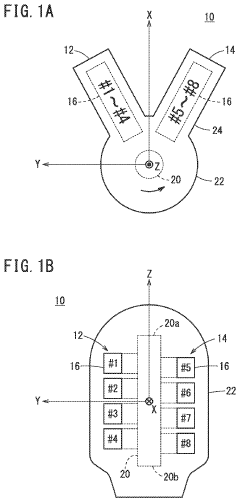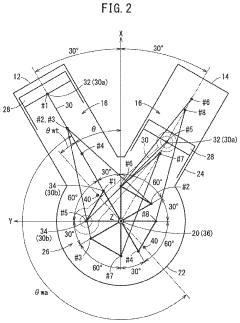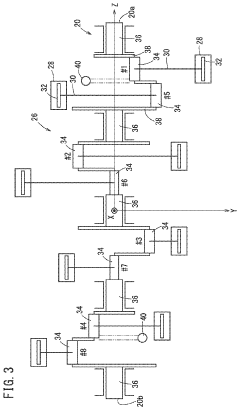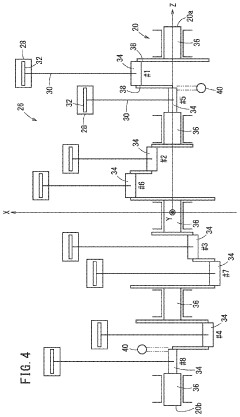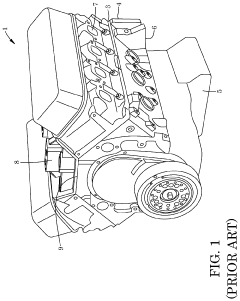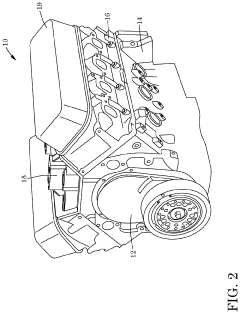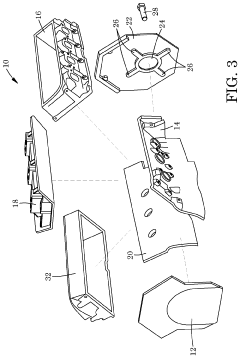How Could V8 Engines Transform High-Performance Cars?
JUL 4, 20259 MIN READ
Generate Your Research Report Instantly with AI Agent
Patsnap Eureka helps you evaluate technical feasibility & market potential.
V8 Engine Evolution
The V8 engine has undergone significant evolution since its inception, transforming high-performance cars and shaping the automotive industry. This powerful engine configuration has a rich history dating back to the early 20th century, with continuous improvements in design, materials, and technology driving its development.
In the 1930s, the first V8 engines emerged, offering increased power and smoother operation compared to their inline counterparts. These early V8s were primarily used in luxury and performance vehicles, setting the stage for future advancements. The post-World War II era saw a surge in V8 popularity, particularly in American muscle cars, where manufacturers competed to produce more powerful and efficient engines.
The 1960s and 1970s marked a golden age for V8 engines, with iconic models like the Ford Mustang and Chevrolet Camaro showcasing their potential. During this period, advancements in fuel injection, valve timing, and materials science contributed to improved performance and reliability. However, the oil crisis of the 1970s led to a temporary decline in V8 popularity as fuel efficiency became a priority.
The 1980s and 1990s witnessed a resurgence of V8 engines, driven by technological innovations. Electronic fuel injection, computer-controlled engine management systems, and variable valve timing allowed for better fuel economy without sacrificing power. This era also saw the introduction of overhead cam V8 designs, further enhancing performance and efficiency.
In the 21st century, V8 engines have continued to evolve, adapting to stricter emissions regulations and the demand for improved fuel economy. Modern V8s incorporate advanced technologies such as direct fuel injection, cylinder deactivation, and turbocharging to achieve higher power outputs while reducing fuel consumption and emissions. These innovations have allowed V8 engines to remain relevant in an era of increasing environmental concerns.
The integration of hybrid and electric technologies has opened new avenues for V8 engine development. Some manufacturers have combined V8 engines with electric motors to create high-performance hybrid powertrains, offering the best of both worlds: the raw power of a V8 and the efficiency of electric propulsion. This hybrid approach has enabled V8 engines to maintain their position in the high-performance car segment while meeting increasingly stringent environmental standards.
Looking ahead, the future of V8 engines in high-performance cars will likely involve further refinements in materials, manufacturing processes, and integration with electrification technologies. As the automotive industry transitions towards more sustainable solutions, V8 engines may evolve to incorporate alternative fuels or become part of more advanced hybrid systems, ensuring their continued relevance in the world of high-performance vehicles.
In the 1930s, the first V8 engines emerged, offering increased power and smoother operation compared to their inline counterparts. These early V8s were primarily used in luxury and performance vehicles, setting the stage for future advancements. The post-World War II era saw a surge in V8 popularity, particularly in American muscle cars, where manufacturers competed to produce more powerful and efficient engines.
The 1960s and 1970s marked a golden age for V8 engines, with iconic models like the Ford Mustang and Chevrolet Camaro showcasing their potential. During this period, advancements in fuel injection, valve timing, and materials science contributed to improved performance and reliability. However, the oil crisis of the 1970s led to a temporary decline in V8 popularity as fuel efficiency became a priority.
The 1980s and 1990s witnessed a resurgence of V8 engines, driven by technological innovations. Electronic fuel injection, computer-controlled engine management systems, and variable valve timing allowed for better fuel economy without sacrificing power. This era also saw the introduction of overhead cam V8 designs, further enhancing performance and efficiency.
In the 21st century, V8 engines have continued to evolve, adapting to stricter emissions regulations and the demand for improved fuel economy. Modern V8s incorporate advanced technologies such as direct fuel injection, cylinder deactivation, and turbocharging to achieve higher power outputs while reducing fuel consumption and emissions. These innovations have allowed V8 engines to remain relevant in an era of increasing environmental concerns.
The integration of hybrid and electric technologies has opened new avenues for V8 engine development. Some manufacturers have combined V8 engines with electric motors to create high-performance hybrid powertrains, offering the best of both worlds: the raw power of a V8 and the efficiency of electric propulsion. This hybrid approach has enabled V8 engines to maintain their position in the high-performance car segment while meeting increasingly stringent environmental standards.
Looking ahead, the future of V8 engines in high-performance cars will likely involve further refinements in materials, manufacturing processes, and integration with electrification technologies. As the automotive industry transitions towards more sustainable solutions, V8 engines may evolve to incorporate alternative fuels or become part of more advanced hybrid systems, ensuring their continued relevance in the world of high-performance vehicles.
Market Demand Analysis
The market demand for high-performance cars equipped with V8 engines remains robust, driven by enthusiasts and luxury car buyers seeking powerful, exhilarating driving experiences. Despite increasing environmental concerns and stricter emissions regulations, V8-powered vehicles continue to hold a significant market share in the premium and sports car segments.
In recent years, the global high-performance car market has shown steady growth, with V8 engines playing a crucial role in this expansion. The market size for high-performance vehicles is projected to reach substantial figures in the coming years, with V8-powered cars contributing significantly to this growth. This demand is particularly strong in regions such as North America, Europe, and the Middle East, where car culture and disposable income support the purchase of high-end vehicles.
The appeal of V8 engines in high-performance cars stems from their ability to deliver exceptional power, torque, and acceleration. These characteristics align with consumer preferences for vehicles that offer thrilling driving dynamics and prestigious brand associations. V8-powered cars often serve as flagship models for automotive manufacturers, commanding premium prices and higher profit margins.
However, the market for V8 engines in high-performance cars faces challenges. Increasing fuel efficiency standards and environmental regulations are pushing manufacturers to explore alternative powertrain technologies. This has led to a trend of downsizing and turbocharging engines, as well as the development of hybrid and electric powertrains.
Despite these challenges, there is a growing niche market for V8-powered high-performance cars that incorporate advanced technologies to improve efficiency and reduce emissions. This includes the integration of cylinder deactivation systems, start-stop technology, and mild hybrid systems. These innovations allow V8 engines to remain relevant in an increasingly eco-conscious market while maintaining their performance characteristics.
The market demand analysis also reveals a shift towards more versatile high-performance vehicles. Consumers are increasingly seeking cars that offer both track-capable performance and everyday usability. This trend has led to the rise of high-performance SUVs and crossovers equipped with V8 engines, expanding the market beyond traditional sports cars and luxury sedans.
Looking ahead, the market for V8-powered high-performance cars is expected to evolve. While overall demand may face pressure from environmental regulations and changing consumer preferences, there will likely remain a dedicated segment of buyers who value the unique characteristics of V8 engines. Manufacturers are likely to focus on producing limited edition, high-value models that showcase the pinnacle of V8 technology and performance, catering to collectors and enthusiasts willing to pay a premium for these vehicles.
In recent years, the global high-performance car market has shown steady growth, with V8 engines playing a crucial role in this expansion. The market size for high-performance vehicles is projected to reach substantial figures in the coming years, with V8-powered cars contributing significantly to this growth. This demand is particularly strong in regions such as North America, Europe, and the Middle East, where car culture and disposable income support the purchase of high-end vehicles.
The appeal of V8 engines in high-performance cars stems from their ability to deliver exceptional power, torque, and acceleration. These characteristics align with consumer preferences for vehicles that offer thrilling driving dynamics and prestigious brand associations. V8-powered cars often serve as flagship models for automotive manufacturers, commanding premium prices and higher profit margins.
However, the market for V8 engines in high-performance cars faces challenges. Increasing fuel efficiency standards and environmental regulations are pushing manufacturers to explore alternative powertrain technologies. This has led to a trend of downsizing and turbocharging engines, as well as the development of hybrid and electric powertrains.
Despite these challenges, there is a growing niche market for V8-powered high-performance cars that incorporate advanced technologies to improve efficiency and reduce emissions. This includes the integration of cylinder deactivation systems, start-stop technology, and mild hybrid systems. These innovations allow V8 engines to remain relevant in an increasingly eco-conscious market while maintaining their performance characteristics.
The market demand analysis also reveals a shift towards more versatile high-performance vehicles. Consumers are increasingly seeking cars that offer both track-capable performance and everyday usability. This trend has led to the rise of high-performance SUVs and crossovers equipped with V8 engines, expanding the market beyond traditional sports cars and luxury sedans.
Looking ahead, the market for V8-powered high-performance cars is expected to evolve. While overall demand may face pressure from environmental regulations and changing consumer preferences, there will likely remain a dedicated segment of buyers who value the unique characteristics of V8 engines. Manufacturers are likely to focus on producing limited edition, high-value models that showcase the pinnacle of V8 technology and performance, catering to collectors and enthusiasts willing to pay a premium for these vehicles.
Technical Challenges
The integration of V8 engines into high-performance cars presents several significant technical challenges that manufacturers must overcome to fully harness their potential. One of the primary obstacles is managing the increased heat generation associated with these powerful engines. V8 engines, particularly in high-performance configurations, produce substantial amounts of heat that can affect both engine performance and overall vehicle dynamics. Engineers must develop advanced cooling systems and heat management strategies to maintain optimal operating temperatures and prevent thermal-related issues.
Weight distribution is another critical challenge when incorporating V8 engines into high-performance vehicles. These engines are typically larger and heavier than their smaller counterparts, which can significantly impact the car's balance and handling characteristics. Designers must carefully consider the engine's placement and weight distribution to maintain or enhance the vehicle's overall performance and driving dynamics. This often involves extensive chassis and suspension modifications to accommodate the increased weight and power output.
Fuel efficiency and emissions compliance pose additional hurdles for V8-powered high-performance cars. As global regulations become increasingly stringent, manufacturers must find innovative ways to improve fuel economy and reduce emissions without compromising performance. This challenge has led to the development of technologies such as cylinder deactivation, direct injection, and advanced engine management systems. However, balancing these environmental considerations with the power demands of high-performance applications remains an ongoing challenge.
The integration of advanced electronic systems and control units presents another technical hurdle. Modern V8 engines require sophisticated engine management systems to optimize performance, fuel efficiency, and emissions. Developing and fine-tuning these systems to work seamlessly with the engine and other vehicle components is a complex task that requires significant expertise and resources.
Durability and reliability are also key concerns when pushing V8 engines to their limits in high-performance applications. The increased stress on engine components due to higher power outputs and operating temperatures can lead to accelerated wear and potential failures. Engineers must employ advanced materials, design techniques, and manufacturing processes to ensure that these engines can withstand the rigors of high-performance driving while maintaining long-term reliability.
Lastly, the challenge of noise, vibration, and harshness (NVH) management is particularly relevant for V8 engines in high-performance cars. While the distinctive sound of a V8 is often desirable, excessive noise and vibration can detract from the overall driving experience and comfort. Manufacturers must strike a delicate balance between preserving the engine's character and meeting regulatory requirements for noise emissions, all while ensuring a refined and comfortable driving experience.
Weight distribution is another critical challenge when incorporating V8 engines into high-performance vehicles. These engines are typically larger and heavier than their smaller counterparts, which can significantly impact the car's balance and handling characteristics. Designers must carefully consider the engine's placement and weight distribution to maintain or enhance the vehicle's overall performance and driving dynamics. This often involves extensive chassis and suspension modifications to accommodate the increased weight and power output.
Fuel efficiency and emissions compliance pose additional hurdles for V8-powered high-performance cars. As global regulations become increasingly stringent, manufacturers must find innovative ways to improve fuel economy and reduce emissions without compromising performance. This challenge has led to the development of technologies such as cylinder deactivation, direct injection, and advanced engine management systems. However, balancing these environmental considerations with the power demands of high-performance applications remains an ongoing challenge.
The integration of advanced electronic systems and control units presents another technical hurdle. Modern V8 engines require sophisticated engine management systems to optimize performance, fuel efficiency, and emissions. Developing and fine-tuning these systems to work seamlessly with the engine and other vehicle components is a complex task that requires significant expertise and resources.
Durability and reliability are also key concerns when pushing V8 engines to their limits in high-performance applications. The increased stress on engine components due to higher power outputs and operating temperatures can lead to accelerated wear and potential failures. Engineers must employ advanced materials, design techniques, and manufacturing processes to ensure that these engines can withstand the rigors of high-performance driving while maintaining long-term reliability.
Lastly, the challenge of noise, vibration, and harshness (NVH) management is particularly relevant for V8 engines in high-performance cars. While the distinctive sound of a V8 is often desirable, excessive noise and vibration can detract from the overall driving experience and comfort. Manufacturers must strike a delicate balance between preserving the engine's character and meeting regulatory requirements for noise emissions, all while ensuring a refined and comfortable driving experience.
Current V8 Solutions
01 Cylinder configuration and design
V8 engine performance can be enhanced through optimized cylinder configuration and design. This includes improvements in cylinder head geometry, valve placement, and combustion chamber design to increase efficiency and power output. Advanced manufacturing techniques and materials may be used to reduce weight and improve heat dissipation.- Cylinder configuration and design: V8 engine performance can be enhanced through optimized cylinder configuration and design. This includes improvements in cylinder head geometry, valve arrangement, and combustion chamber design to increase efficiency and power output.
- Fuel injection and combustion optimization: Advanced fuel injection systems and combustion optimization techniques are employed to improve V8 engine performance. This involves precise fuel delivery, improved atomization, and enhanced mixture formation for better combustion efficiency and power generation.
- Turbocharging and supercharging: Forced induction methods such as turbocharging and supercharging are utilized to boost V8 engine performance. These technologies increase air intake, allowing for more fuel combustion and resulting in higher power output and improved efficiency.
- Variable valve timing and lift: Implementation of variable valve timing and lift systems in V8 engines allows for optimized air intake and exhaust flow across different engine speeds. This technology enhances performance, fuel efficiency, and reduces emissions throughout the engine's operating range.
- Engine management and electronic control: Advanced engine management systems and electronic control units are employed to fine-tune V8 engine performance. These systems optimize various parameters such as ignition timing, fuel injection, and air-fuel ratio in real-time, resulting in improved power delivery and efficiency.
02 Fuel injection and ignition systems
Performance improvements in V8 engines can be achieved through advanced fuel injection and ignition systems. This may involve direct injection technology, variable fuel injection timing, and precision ignition control. These systems optimize fuel delivery and combustion, resulting in increased power output and improved fuel efficiency.Expand Specific Solutions03 Turbocharging and supercharging
Forced induction systems, such as turbochargers and superchargers, can significantly boost V8 engine performance. These systems increase air intake, allowing for more fuel to be burned and resulting in higher power output. Advanced designs may include variable geometry turbochargers or electric superchargers for improved response and efficiency.Expand Specific Solutions04 Variable valve timing and lift
Implementing variable valve timing and lift mechanisms in V8 engines can optimize performance across different operating conditions. These systems allow for dynamic adjustment of valve operation, improving low-end torque, high-end power, and overall efficiency. Advanced designs may incorporate camless valve actuation for even greater control.Expand Specific Solutions05 Engine management and control systems
Sophisticated engine management and control systems play a crucial role in maximizing V8 engine performance. These systems utilize advanced sensors and algorithms to optimize various engine parameters in real-time, including fuel injection, ignition timing, and valve operation. Integration with vehicle dynamics systems can further enhance overall performance and drivability.Expand Specific Solutions
Key Manufacturers
The V8 engine market in high-performance cars is in a mature stage, with established players like GM, Honda, and Hyundai dominating the landscape. However, the industry is experiencing a shift towards more efficient and environmentally friendly technologies. The market size remains substantial, driven by demand for luxury and sports vehicles. Technologically, V8 engines are well-developed, but companies are focusing on innovations to improve fuel efficiency and reduce emissions. Key players like GM Global Technology Operations, Honda Motor Co., and Hyundai Motor Co. are investing in research and development to maintain their competitive edge, while newer entrants such as BYD and Great Wall Motor are challenging the status quo with alternative powertrain technologies.
GM Global Technology Operations LLC
Technical Solution: GM's approach to transforming high-performance cars with V8 engines focuses on advanced technologies like Dynamic Fuel Management (DFM) and Active Fuel Management (AFM). These systems allow the engine to operate on fewer cylinders when full power isn't needed, improving fuel efficiency without sacrificing performance[1]. GM has also implemented direct injection and variable valve timing in their V8 engines, enhancing power output and fuel economy. The company's latest V8 engines, such as the 6.2L LT2 used in the Corvette, feature a flat-plane crank design, which allows for higher revs and improved throttle response[2]. Additionally, GM is exploring hybrid V8 systems to further boost performance while meeting stricter emissions standards[3].
Strengths: Balances high performance with improved fuel efficiency, maintains traditional V8 appeal while incorporating modern technologies. Weaknesses: Still faces challenges in meeting increasingly stringent emissions regulations, potential high costs for advanced technologies.
Honda Motor Co., Ltd.
Technical Solution: Honda's approach to V8 engines in high-performance cars is somewhat limited, as they have historically focused more on smaller displacement engines. However, Honda has developed V8 engines for specific applications, such as their racing programs. In Formula 1, Honda has produced highly advanced 1.6L V6 turbo-hybrid power units, which, while not V8s, demonstrate their capability in high-performance engine design[1]. For road cars, Honda has explored V8 technology in concepts like the HSV-010 GT race car, which featured a 3.4L naturally aspirated V8[2]. Honda's expertise in VTEC (Variable Valve Timing and Lift Electronic Control) technology could potentially be applied to V8 engines to enhance performance and efficiency if they choose to develop them for high-performance road cars in the future[3].
Strengths: Expertise in advanced engine technologies like VTEC, proven track record in high-performance racing engines. Weaknesses: Limited experience with V8 engines in production vehicles, may need to catch up with competitors in this specific area.
Core V8 Innovations
V8 engine
PatentActiveUS20230109196A1
Innovation
- The V8 engine configuration features crank pins arranged at 90° intervals on one bank and offset by 60° on the other bank, allowing for cancellation of primary inertia couples without additional specialized components by optimizing the arrangement of crank pins and connecting rods.
Kit for transforming a hot rod into an electric car
PatentActiveUS20210122336A1
Innovation
- A kit comprising a faux transmission housing and castings that house an electric motor, designed to mimic the appearance of a V8 engine, including a bell housing, timing cover casting, side castings, and intake manifold casting, which can be easily assembled to conceal the electric motor and resemble a gasoline engine.
Emissions Regulations
Emissions regulations have become a critical factor in shaping the future of high-performance cars, particularly those equipped with V8 engines. As governments worldwide implement increasingly stringent environmental policies, automakers are compelled to adapt their powertrains to meet these new standards while maintaining performance levels.
In recent years, many countries have introduced strict CO2 emission targets for passenger vehicles. The European Union, for instance, has set a fleet-wide average emission target of 95g CO2/km by 2021, with further reductions planned for the coming years. Similarly, the United States has established Corporate Average Fuel Economy (CAFE) standards that require manufacturers to improve fuel efficiency and reduce emissions across their vehicle lineup.
These regulations pose significant challenges for V8-powered high-performance cars, which traditionally have been associated with high fuel consumption and emissions. Manufacturers are now exploring various technologies to ensure compliance while preserving the power and character of V8 engines. One approach is the implementation of cylinder deactivation systems, which allow the engine to operate on fewer cylinders during low-load conditions, thereby improving fuel efficiency and reducing emissions.
Another strategy involves the integration of hybrid powertrains with V8 engines. This combination allows for electric assistance during acceleration and low-speed driving, reducing the overall fuel consumption and emissions of the vehicle. Some manufacturers have also experimented with mild-hybrid systems, which use a small electric motor to provide additional power and improve efficiency without the complexity of a full hybrid system.
Advanced fuel injection technologies, such as direct injection and dual injection systems, are being employed to optimize fuel delivery and combustion processes in V8 engines. These innovations contribute to improved fuel efficiency and reduced emissions without compromising performance. Additionally, the use of lightweight materials in engine construction helps to reduce overall vehicle weight, further enhancing efficiency and performance.
Despite these advancements, the long-term viability of V8 engines in high-performance cars remains uncertain. Some manufacturers are exploring alternative powertrains, such as smaller turbocharged engines or all-electric systems, to meet emissions targets while delivering comparable performance. However, the unique characteristics of V8 engines, including their distinctive sound and power delivery, continue to appeal to enthusiasts and present a challenge for alternative solutions to fully replicate.
As emissions regulations continue to evolve, the transformation of V8 engines in high-performance cars will likely accelerate. Manufacturers will need to balance the demands of performance, efficiency, and regulatory compliance to ensure the continued relevance of these iconic powerplants in an increasingly environmentally conscious automotive landscape.
In recent years, many countries have introduced strict CO2 emission targets for passenger vehicles. The European Union, for instance, has set a fleet-wide average emission target of 95g CO2/km by 2021, with further reductions planned for the coming years. Similarly, the United States has established Corporate Average Fuel Economy (CAFE) standards that require manufacturers to improve fuel efficiency and reduce emissions across their vehicle lineup.
These regulations pose significant challenges for V8-powered high-performance cars, which traditionally have been associated with high fuel consumption and emissions. Manufacturers are now exploring various technologies to ensure compliance while preserving the power and character of V8 engines. One approach is the implementation of cylinder deactivation systems, which allow the engine to operate on fewer cylinders during low-load conditions, thereby improving fuel efficiency and reducing emissions.
Another strategy involves the integration of hybrid powertrains with V8 engines. This combination allows for electric assistance during acceleration and low-speed driving, reducing the overall fuel consumption and emissions of the vehicle. Some manufacturers have also experimented with mild-hybrid systems, which use a small electric motor to provide additional power and improve efficiency without the complexity of a full hybrid system.
Advanced fuel injection technologies, such as direct injection and dual injection systems, are being employed to optimize fuel delivery and combustion processes in V8 engines. These innovations contribute to improved fuel efficiency and reduced emissions without compromising performance. Additionally, the use of lightweight materials in engine construction helps to reduce overall vehicle weight, further enhancing efficiency and performance.
Despite these advancements, the long-term viability of V8 engines in high-performance cars remains uncertain. Some manufacturers are exploring alternative powertrains, such as smaller turbocharged engines or all-electric systems, to meet emissions targets while delivering comparable performance. However, the unique characteristics of V8 engines, including their distinctive sound and power delivery, continue to appeal to enthusiasts and present a challenge for alternative solutions to fully replicate.
As emissions regulations continue to evolve, the transformation of V8 engines in high-performance cars will likely accelerate. Manufacturers will need to balance the demands of performance, efficiency, and regulatory compliance to ensure the continued relevance of these iconic powerplants in an increasingly environmentally conscious automotive landscape.
Performance Metrics
V8 engines have long been synonymous with high-performance cars, offering a unique combination of power, responsiveness, and auditory satisfaction. To quantify the transformative impact of V8 engines on high-performance vehicles, several key performance metrics must be considered.
Acceleration is perhaps the most immediately noticeable metric. V8-powered cars typically demonstrate superior 0-60 mph times compared to their lower-cylinder counterparts. This rapid acceleration is attributed to the V8's ability to produce high torque at lower RPMs, providing instant power delivery. Many modern V8 sports cars can achieve 0-60 mph times in the sub-3-second range, a feat that was once reserved for exotic supercars.
Top speed is another crucial metric where V8 engines excel. The increased power output allows these vehicles to reach and sustain higher velocities. While many production cars are electronically limited for safety reasons, unrestricted V8-powered vehicles can often exceed 200 mph, pushing the boundaries of road-legal performance.
Horsepower and torque figures are fundamental in assessing engine performance. V8 engines typically produce higher outputs in both categories compared to smaller displacement engines. Modern V8s can generate upwards of 600 horsepower and 500 lb-ft of torque, providing the raw power necessary for exceptional performance across various driving scenarios.
Power-to-weight ratio is a critical metric that directly influences a car's overall performance. V8 engines, despite their size, often contribute to favorable power-to-weight ratios due to their high output. This metric is particularly important in racing applications, where every pound matters in the pursuit of speed and agility.
Throttle response and power delivery characteristics are less quantifiable but equally important metrics. V8 engines are renowned for their linear power delivery and immediate throttle response, enhancing driver control and confidence. This responsiveness translates to improved lap times on racetracks and a more engaging driving experience on public roads.
Fuel efficiency, while not traditionally associated with V8 engines, has seen significant improvements in recent years. Advanced technologies such as cylinder deactivation and direct injection have allowed V8-powered cars to achieve better fuel economy without sacrificing performance. This metric is increasingly important as manufacturers strive to meet stringent emissions regulations while maintaining high performance standards.
In conclusion, the performance metrics of V8-powered high-performance cars demonstrate their transformative capabilities across various aspects of automotive excellence. From blistering acceleration and top speeds to impressive power outputs and enhanced driving dynamics, V8 engines continue to push the boundaries of what's possible in the realm of high-performance vehicles.
Acceleration is perhaps the most immediately noticeable metric. V8-powered cars typically demonstrate superior 0-60 mph times compared to their lower-cylinder counterparts. This rapid acceleration is attributed to the V8's ability to produce high torque at lower RPMs, providing instant power delivery. Many modern V8 sports cars can achieve 0-60 mph times in the sub-3-second range, a feat that was once reserved for exotic supercars.
Top speed is another crucial metric where V8 engines excel. The increased power output allows these vehicles to reach and sustain higher velocities. While many production cars are electronically limited for safety reasons, unrestricted V8-powered vehicles can often exceed 200 mph, pushing the boundaries of road-legal performance.
Horsepower and torque figures are fundamental in assessing engine performance. V8 engines typically produce higher outputs in both categories compared to smaller displacement engines. Modern V8s can generate upwards of 600 horsepower and 500 lb-ft of torque, providing the raw power necessary for exceptional performance across various driving scenarios.
Power-to-weight ratio is a critical metric that directly influences a car's overall performance. V8 engines, despite their size, often contribute to favorable power-to-weight ratios due to their high output. This metric is particularly important in racing applications, where every pound matters in the pursuit of speed and agility.
Throttle response and power delivery characteristics are less quantifiable but equally important metrics. V8 engines are renowned for their linear power delivery and immediate throttle response, enhancing driver control and confidence. This responsiveness translates to improved lap times on racetracks and a more engaging driving experience on public roads.
Fuel efficiency, while not traditionally associated with V8 engines, has seen significant improvements in recent years. Advanced technologies such as cylinder deactivation and direct injection have allowed V8-powered cars to achieve better fuel economy without sacrificing performance. This metric is increasingly important as manufacturers strive to meet stringent emissions regulations while maintaining high performance standards.
In conclusion, the performance metrics of V8-powered high-performance cars demonstrate their transformative capabilities across various aspects of automotive excellence. From blistering acceleration and top speeds to impressive power outputs and enhanced driving dynamics, V8 engines continue to push the boundaries of what's possible in the realm of high-performance vehicles.
Unlock deeper insights with Patsnap Eureka Quick Research — get a full tech report to explore trends and direct your research. Try now!
Generate Your Research Report Instantly with AI Agent
Supercharge your innovation with Patsnap Eureka AI Agent Platform!
